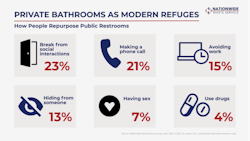America’s Last Safe Space? How the Bathroom Became a Place to Escape, Hide, and Breathe
- Nearly 1 in 2 Americans use public restrooms for more, to escape, reset, or avoid interaction.
- Shame of a bowel movement when the partner is nearby affects millions.
- 25% of citizens feel uncomfortable having to use a public restroom with open stalls.
GILBERT, AZ — The Great Bathroom Survey, published by Nationwide Waste Service, a leading provider of portable sanitary solutions, polled 2,000 Americans to find out what really happens behind closed restroom doors.
The survey reveals that public restrooms are more than functional spaces, they have become a quiet escape from the pressures of daily life. Whether it's a break from work, a moment away from others, or a safe place to breathe, the bathroom is increasingly seen as a personal refuge.
The Great Bathroom Survey set out to explore how Americans experience public restrooms, revealing a striking paradox: they are both a refuge from the outside world and a place where many still feel vulnerable or ashamed.
The Restroom Became a Safe Space
While 54% of Americans say they use public restrooms only for their intended purpose, the other half reveal something more complex. For many, the stall has become a space to pause, recharge, or retreat.
According to the survey, 15% of Americans admit to using the restroom to avoid work, and 13% say they have hidden from someone or something inside. These behaviors reflect a growing need for boundaries in overstimulated environments, whether it's a quiet moment away from deadlines or a way to escape social pressure.
Most notably, 1 in 5 Americans have used a public restroom to take a break from social interaction. Among Gen Z, that number jumps to 50%, indicating that younger generations in particular turn to restrooms as a way to decompress and find brief moments of solitude.
In more extreme cases, restrooms are also used for intimate or risky purposes: 7% of respondents say they have had sex in one, and 4% report drug use. While less common, these behaviors point to a deeper truth: the bathroom is one of the only socially acceptable places to step away, without having to leave.
Privacy, Pressure, and the Fear of Being Heard
A toilet stall offers some kind of privacy but that doesn’t always translate to comfort, especially when it comes to going number two. According to the survey, 45% of Americans feel uncomfortable using a restroom for a bowel movement in public settings, such as restaurants, museums, or events.
The discomfort is shaped by gender, environment, and proximity to others. Nearly half of all women (49%) say they feel uneasy doing so in public, and 1 in 3 experience that same discomfort at work.
Even though younger generations are generally more open and uninhibited, 16% of Gen Z respondents say they feel bathroom shame at school or college, especially when others are in earshot.
1 in 4 respondents report feeling uncomfortable when the stall has an open top or bottom. Even though it's a common design feature, it's often overlooked, yet deeply unsettling to many. Instead of offering a true sense of privacy, these partial enclosures can heighten anxiety, self-consciousness, and the feeling of being exposed. For a space that’s meant to provide relief, the lack of visual and acoustic separation often does the opposite: it reinforces discomfort rather than easing it.
Modern restrooms may meet physical needs, but not always emotional ones. Design, social norms, and emotional safety are all part of the equation, and they're still evolving.
Shame of Going in Front of a Partner Affects Millions
Among younger adults, 14% of those aged 25 to 34 say they struggle to have a bowel movement if their partner is nearby. Even in intimate relationships, the pressure to appear composed and “in control” extends into the restroom. It’s a reminder that for many, bodily functions still carry a quiet sense of vulnerability, even in the most trusted spaces. What should be routine becomes something to hide, revealing how deep-rooted bathroom shame can be.
About the Survey
The survey was commissioned by Nationwide Waste Service and conducted by the independent research institute Censuswide. A total of 2,000 US adults (18+) participated between April 2 and April 4, 2025, including 873 men and 1,127 women. The survey was conducted online and included participants from all 50 US states. The sample was balanced across gender, region, and age groups to broadly represent the US adult population.
The full results of the Great Bathroom Survey, offering insights into the rise of screen time during bathroom breaks can be explored at https://nationwidewasteservice.com/the-secret-getaway-the-public-restroom/


